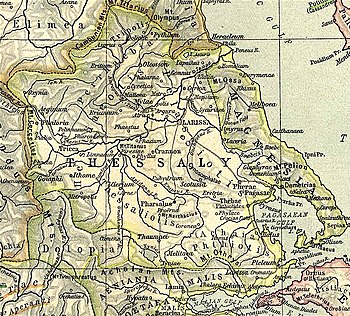Our website is made possible by displaying online advertisements to our visitors.
Please consider supporting us by disabling your ad blocker.
Casthanaea
39°35′25″N 22°55′13″E / 39.5904°N 22.9204°E

Casthanaea or Casthanea or Kasthanaia or Kasthaneia (Greek: Κασθαναία)[1] or Castanea or Kastanaia (Κασταναία)[2] was a town and polis (city-state)[3] of Ancient Magnesia, at the foot of Mount Pelium, with a temple of Aphrodite Casthanitis. It is mentioned by Herodotus in his account of the terrible storm which the fleet of Xerxes I experienced off this part of the coast.[4] and by Pliny.[5] It was from this town that the chestnut tree, which still abounds on the eastern side of Mt. Pelium, derived its name in Greek and the modern languages of Europe.[6] Its location is at the modern village of Keramidi.[7][8]
- ^ Strabo. Geographica. Vol. Strab. ix. pp.438, 443. Page numbers refer to those of Isaac Casaubon's edition.
- ^ Stephanus of Byzantium. Ethnica. Vol. s.v.
- ^ Mogens Herman Hansen & Thomas Heine Nielsen (2004). "Thessaly and Adjacent Regions". An inventory of archaic and classical poleis. New York: Oxford University Press. p. 719. ISBN 0-19-814099-1.
- ^ Herodotus. Histories. Vol. 7.183, 184, 188.
- ^ Pliny. Naturalis Historia. Vol. 4.16.9.
- ^ "Essai monographique sur le châtaignier", Édouard Lamy, 1860 p.4.
- ^ Richard Talbert, ed. (2000). Barrington Atlas of the Greek and Roman World. Princeton University Press. p. 55, and directory notes accompanying. ISBN 978-0-691-03169-9.
- ^ Lund University. Digital Atlas of the Roman Empire.
Previous Page Next Page


